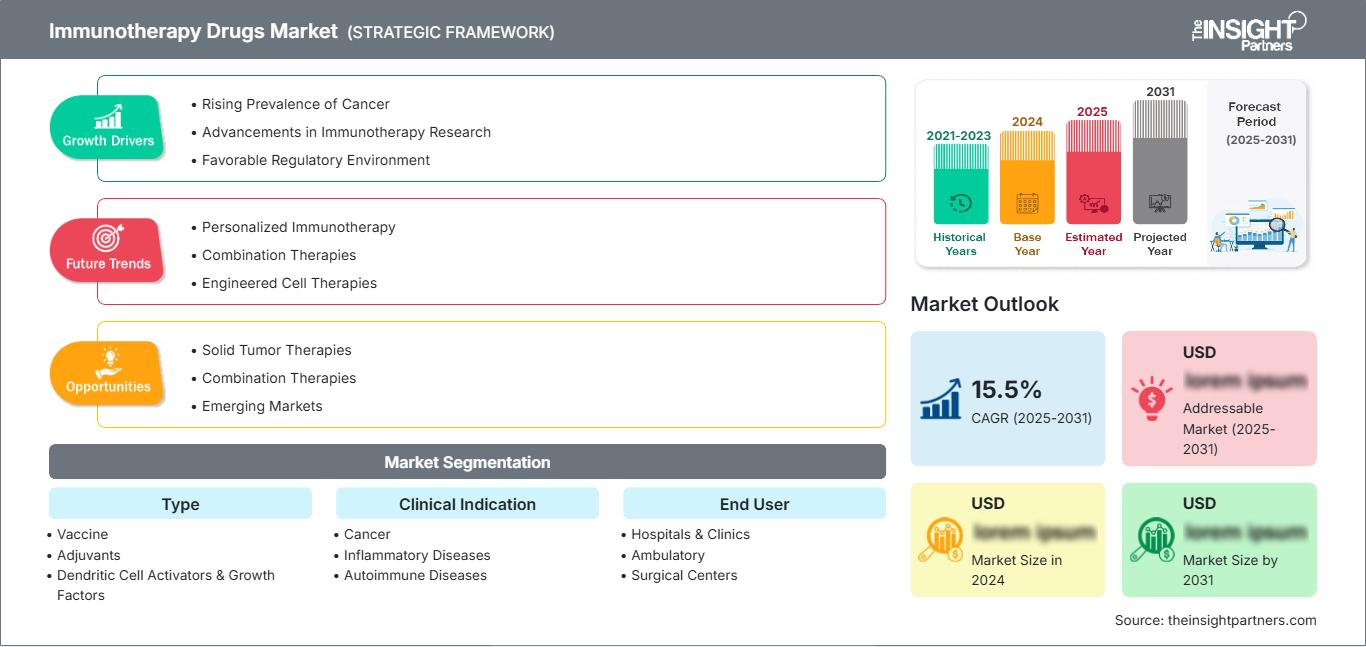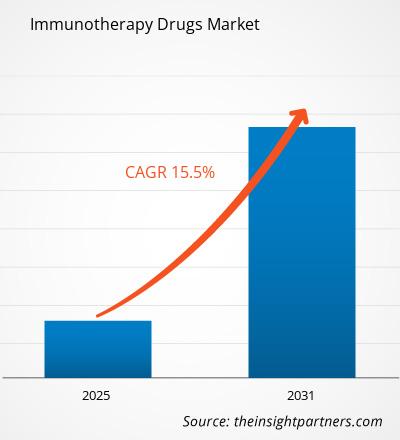Si prevede che il mercato dei farmaci per immunoterapia raggiungerà i 391,81 miliardi di dollari entro il 2031. Si prevede che il mercato registrerà un CAGR del 10,2% nel periodo 2025-2031.
Il rapporto è segmentato in base al tipo (vaccino, adiuvanti, attivatori di cellule dendritiche e fattori di crescita, stimolatori delle cellule T e fattori di crescita, inibitori dei checkpoint immunitari, anticorpi monoclonali, interleuchine e interferoni, altri) e all'indicazione clinica (cancro, malattie infiammatorie, malattie autoimmuni, malattie infettive, altri). L'analisi globale è ulteriormente suddivisa a livello regionale e per i principali paesi.
Scopo del rapporto
Il rapporto Immunotherapy Drugs Market di The Insight Partners mira a descrivere il panorama attuale e la crescita futura, i principali fattori trainanti, le sfide e le opportunità. Ciò fornirà spunti a vari stakeholder aziendali, come:
- Fornitori/produttori di tecnologia: per comprendere le dinamiche di mercato in evoluzione e conoscere le potenziali opportunità di crescita, consentendo loro di prendere decisioni strategiche informate.
- Investitori: per condurre un'analisi completa delle tendenze in merito al tasso di crescita del mercato, alle proiezioni finanziarie del mercato e alle opportunità esistenti lungo la catena del valore.
- Organismi di regolamentazione: per regolamentare le politiche e le attività di controllo nel mercato con l'obiettivo di ridurre al minimo gli abusi, preservare la fiducia degli investitori e sostenere l'integrità e la stabilità del mercato.
Tipo di segmentazione del mercato dei farmaci per immunoterapia
- Vaccino
- Adiuvanti
- Attivatori delle cellule dendritiche e fattori di crescita
- Stimolatori delle cellule T e fattori di crescita
- Inibitori del checkpoint immunitario
- Anticorpi monoclonali
- Interleuchine e interferoni
- Altri
Indicazione clinica
- Cancro
- Malattie infiammatorie
- Malattie autoimmuni
- Malattie infettive
- Altri
Utente finale
- Ospedali e cliniche
- Ambulatoriali
- Centri chirurgici
- Altri
Geografia
- Nord America
- Europa
- Asia-Pacifico
- America meridionale e centrale
- Medio Oriente e Africa
Potrai personalizzare gratuitamente qualsiasi rapporto, comprese parti di questo rapporto, o analisi a livello di paese, pacchetto dati Excel, oltre a usufruire di grandi offerte e sconti per start-up e università
Mercato dei farmaci per l'immunoterapia: Approfondimenti strategici

-
Ottieni le principali tendenze chiave del mercato di questo rapporto.Questo campione GRATUITO includerà l'analisi dei dati, che vanno dalle tendenze di mercato alle stime e alle previsioni.
Fattori di crescita del mercato dei farmaci immunoterapici
- Aumento della prevalenza del cancro: la crescente incidenza di vari tipi di cancro, in particolare i tumori immuno-correlati, sta determinando la domanda di farmaci immunoterapici.
- Progressi nella ricerca sull'immunoterapia: la ricerca e lo sviluppo continui nel campo dell'immunoterapia stanno portando alla scoperta di nuove terapie e combinazioni di trattamenti.
- Contesto normativo favorevole: quadri normativi di supporto e processi di approvazione accelerati stanno accelerando lo sviluppo e la commercializzazione dei farmaci immunoterapici.
Tendenze future del mercato dei farmaci immunoterapici
- Immunoterapia personalizzata: trattamenti immunoterapici personalizzati per i singoli pazienti in base al loro corredo genetico e alle caratteristiche del tumore.
- Terapie combinate: combinazione dell'immunoterapia con altri trattamenti, come chemioterapia e radioterapia, per migliorare l'efficacia e ridurre gli effetti collaterali.
- Terapie cellulari ingegnerizzate: sviluppo di terapie cellulari ingegnerizzate, come la terapia con cellule CAR-T, per colpire specifiche cellule tumorali.
Opportunità di mercato per i farmaci immunoterapici
- Terapie per tumori solidi: ampliamento dell'applicazione dell'immunoterapia per il trattamento di tumori solidi, come il cancro al polmone, al seno e al colon.
- Terapie combinate: sviluppo di terapie combinate innovative per migliorare i risultati dei pazienti e affrontare la resistenza al trattamento.
- Mercati emergenti: puntare ai mercati emergenti con crescenti esigenze sanitarie e una crescente domanda di trattamenti avanzati contro il cancro.
Mercato dei farmaci per l'immunoterapia
Le tendenze regionali e i fattori che influenzano il mercato dei farmaci immunoterapici durante il periodo di previsione sono stati ampiamente spiegati dagli analisti di The Insight Partners. Questa sezione illustra anche i segmenti di mercato e la geografia della gestione delle malattie del ritmo cardiaco in Nord America, Europa, Asia-Pacifico, Medio Oriente e Africa, America meridionale e centrale.
Ambito del rapporto di mercato sui farmaci per l'immunoterapia
| Attributo del rapporto | Dettagli |
|---|---|
| Dimensioni del mercato in 2024 | US$ XX Billion |
| Dimensioni del mercato per 2031 | US$ 391.81 Billion |
| CAGR globale (2025 - 2031) | 10.2% |
| Dati storici | 2021-2023 |
| Periodo di previsione | 2025-2031 |
| Segmenti coperti |
By Tipo
|
| Regioni e paesi coperti |
Nord America
|
| Leader di mercato e profili aziendali chiave |
|
Densità degli operatori del mercato dei farmaci immunoterapici: comprendere il suo impatto sulle dinamiche aziendali
Il mercato dei farmaci immunoterapici è in rapida crescita, trainato dalla crescente domanda da parte degli utenti finali, dovuta a fattori quali l'evoluzione delle preferenze dei consumatori, i progressi tecnologici e una maggiore consapevolezza dei benefici del prodotto. Con l'aumento della domanda, le aziende stanno ampliando la propria offerta, innovando per soddisfare le esigenze dei consumatori e sfruttando le tendenze emergenti, alimentando ulteriormente la crescita del mercato.

- Ottieni il Mercato dei farmaci per l'immunoterapia Panoramica dei principali attori chiave
Punti di forza
- Copertura completa: il rapporto copre in modo completo l'analisi di prodotti, servizi, tipologie e utenti finali del mercato dei farmaci per immunoterapia, fornendo un panorama olistico.
- Analisi di esperti: il rapporto è compilato sulla base della conoscenza approfondita di esperti e analisti del settore.
- Informazioni aggiornate: il rapporto garantisce rilevanza aziendale grazie alla sua copertura di informazioni recenti e tendenze dei dati.
- Opzioni di personalizzazione: questo rapporto può essere personalizzato per soddisfare le esigenze specifiche del cliente e adattarsi in modo appropriato alle strategie aziendali.
Il rapporto di ricerca sul mercato dei farmaci per immunoterapia può, quindi, aiutare a guidare il percorso di decodificazione e comprensione dello scenario del settore e delle prospettive di crescita. Sebbene possano esserci alcune preoccupazioni valide, i vantaggi complessivi di questo rapporto tendono a superare gli svantaggi.
- Analisi storica (2 anni), anno base, previsione (7 anni) con CAGR
- Analisi PEST e SWOT
- Valore/volume delle dimensioni del mercato - Globale, Regionale, Nazionale
- Industria e panorama competitivo
- Set di dati Excel
Report recenti
Rapporti correlati
Testimonianze
Motivo dell'acquisto
- Processo decisionale informato
- Comprensione delle dinamiche di mercato
- Analisi competitiva
- Analisi dei clienti
- Previsioni di mercato
- Mitigazione del rischio
- Pianificazione strategica
- Giustificazione degli investimenti
- Identificazione dei mercati emergenti
- Miglioramento delle strategie di marketing
- Aumento dell'efficienza operativa
- Allineamento alle tendenze normative






















 Ottieni un campione gratuito per - Mercato dei farmaci per l'immunoterapia
Ottieni un campione gratuito per - Mercato dei farmaci per l'immunoterapia